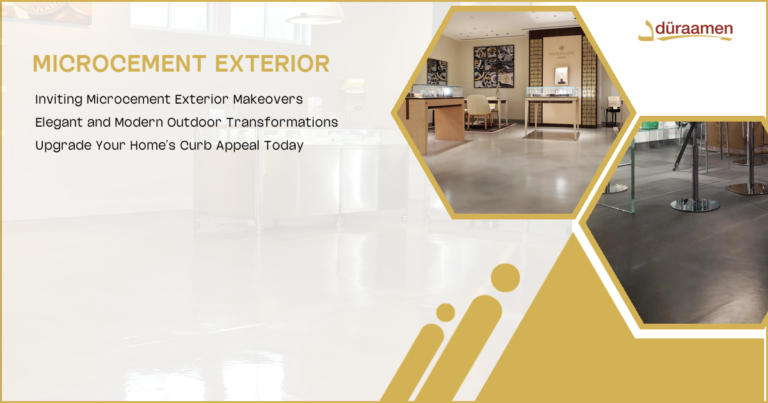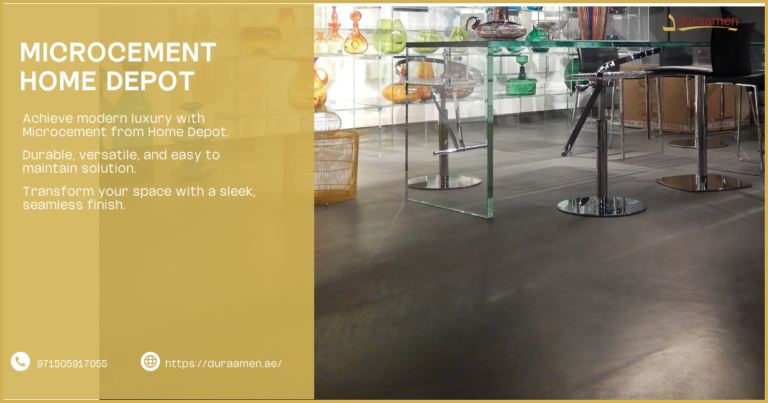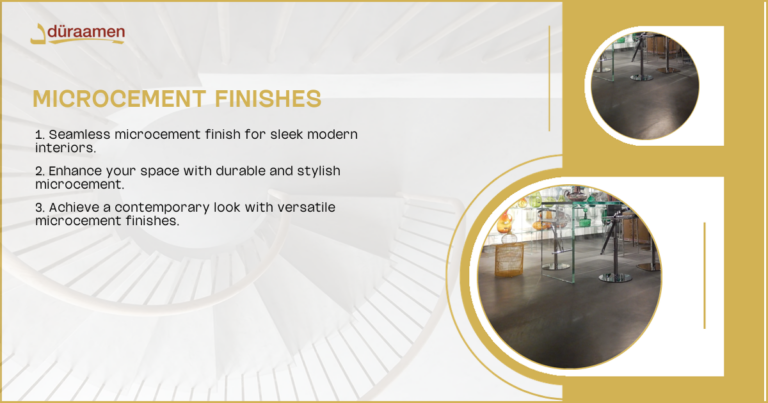Introduction to Floor Finishing Options
When it comes to floor finishing options, two popular choices stand out: microcement and polished concrete. Both offer unique benefits and aesthetic appeal, making them suitable for various applications. Choosing the right floor finish is crucial as it impacts not only the look but also the functionality and durability of your space.
Microcement vs Polished Concrete
What is Microcement?
Microcement is a versatile, thin-layer coating composed of cement, water-based resins, additives, and mineral pigments. It can be applied to various surfaces, including floors, walls, and furniture, providing a seamless and modern finish.
What is Polished Concrete?
Polished concrete is a multi-step process where a concrete floor is mechanically ground, honed, and polished with bonded abrasives to achieve a specified level of gloss. This process enhances the natural beauty of concrete and provides a durable, low-maintenance surface.
Visual Similarities and Key Differences
While both microcement and polished concrete offer sleek, modern aesthetics, they differ in application and finish. Microcement provides more customization options in terms of color and texture, whereas polished concrete showcases the natural beauty of concrete with a glossy finish.
Key Differences:
- Thickness: Microcement is applied in thin layers, while polished concrete involves a thicker slab.
- Customization: Microcement offers more color and texture options.
- Application: Microcement can be applied to various surfaces, while polished concrete is limited to floors.
Advantages of Microcement Over Polished Concrete
More Control of Colour & Finish
Microcement offers extensive customization options, allowing you to choose from a wide range of colors and finishes. This flexibility makes it easier to match your design preferences and achieve a unique look.
- Wide range of color options
- Various textures and finishes
- Customizable to match any design
Low Applied Thickness
One of the significant benefits of microcement is its thin application, typically around 2-3mm. This makes it ideal for renovation projects where adding extra height to the floor is not feasible.
- Thin application (2-3mm)
- Suitable for renovations
- Minimal impact on floor height
Multiple Uses & Applications
Microcement is incredibly versatile and can be used on floors, walls, ceilings, and even furniture. Its adaptability makes it a popular choice for various design projects.
- Suitable for floors, walls, and ceilings
- Can be applied to furniture
- Versatile in design applications
Less Heavy / Noisy Machinery Required
The installation of microcement requires less heavy and noisy machinery compared to polished concrete. This makes the process less disruptive and more suitable for residential areas.
- Minimal machinery required
- Less noise during installation
- Suitable for residential areas
Fast Drying / Installation Time
Microcement has a faster drying and installation time compared to polished concrete. This efficiency can significantly reduce project timelines and minimize downtime.
- Faster drying time
- Quick installation process
- Reduced project timelines
Installation Timing Flexibility
Microcement offers greater flexibility in installation timing, allowing for easier scheduling and coordination with other construction activities.
- Flexible installation timing
- Easier scheduling
- Coordination with other activities
Retro Fitting / Installation Possibilities
Microcement can be easily retrofitted onto existing surfaces, making it an excellent choice for renovation projects. Its thin application allows for seamless integration with existing structures.
- Easy retrofitting
- Suitable for renovations
- Seamless integration with existing surfaces
Less Cracking
Microcement is less prone to cracking compared to polished concrete, thanks to its flexible and resilient composition. This results in a more durable and long-lasting finish.
- Less prone to cracking
- Flexible and resilient
- Durable finish
Compatibility with Underfloor Heating
Microcement is compatible with underfloor heating systems, providing efficient heat distribution and a comfortable living environment.
- Compatible with underfloor heating
- Efficient heat distribution
- Comfortable living environment
Debris Generation
The application of microcement generates less debris compared to polished concrete, making the process cleaner and more manageable.
- Less debris generation
- Cleaner application process
- Easier to manage
Expansion Joints
Microcement requires fewer expansion joints compared to polished concrete, resulting in a more seamless and aesthetically pleasing finish.
- Fewer expansion joints
- Seamless finish
- Aesthetically pleasing
The Appeal of Polished Concrete
Polished concrete is known for its aesthetic and functional benefits. It offers a sleek, modern look that enhances the natural beauty of concrete. Additionally, polished concrete is highly durable and low-maintenance, making it suitable for various environments, including commercial and industrial spaces.
Benefits of Polished Concrete:
- Sleek, modern appearance
- Durable and low-maintenance
- Suitable for commercial and industrial spaces
Installation Process of Polished Concrete 
Preparing the Ground
The first step in installing polished concrete is preparing the ground. This involves cleaning the surface, removing any existing flooring, and ensuring the ground is level.
- Clean the surface
- Remove existing flooring
- Ensure the ground is level
Formwork and Mesh Use
Formwork and mesh are used to provide structural support and ensure the concrete is poured evenly. This step is crucial for achieving a smooth and level finish.
- Provide structural support
- Ensure even pouring
- Achieve a smooth finish
Pouring and Curing the Concrete
Once the formwork and mesh are in place, the concrete is poured and left to cure. Proper curing is essential for achieving the desired strength and durability.
- Pour the concrete
- Allow for proper curing
- Achieve desired strength
Polishing the Floor
The final step involves polishing the floor using bonded abrasives to achieve the desired level of gloss. This process enhances the natural beauty of the concrete and provides a durable finish.
- Use bonded abrasives
- Achieve desired gloss level
- Enhance natural beauty
Microcement and Polished Concrete in Different Settings
Bathrooms
Both microcement and polished concrete are suitable for bathrooms, but microcement offers more customization options and a seamless finish, making it a popular choice for modern bathroom designs.
- Microcement: Customizable and seamless
- Polished Concrete: Durable and low-maintenance
Kitchens
In high-traffic areas like kitchens, both materials perform well. However, microcement’s thin application and versatility make it easier to integrate into existing designs.
- Microcement: Thin application and versatile
- Polished Concrete: Durable and easy to clean
Outdoor Spaces
For outdoor spaces, polished concrete is often preferred due to its durability and weather resistance. However, microcement can also be used if a more customized look is desired.
- Microcement: Customizable for outdoor use
- Polished Concrete: Durable and weather-resistant
Maintenance and Care for Microcement and Polished Concrete 
Daily Cleaning Tips
Both microcement and polished concrete require regular cleaning to maintain their appearance. Use a soft mop and mild detergent for daily cleaning to prevent dirt buildup.
- Use a soft mop
- Mild detergent for cleaning
- Prevent dirt buildup
Annual Protective Layer Renewal
To keep the finish in top condition, it’s essential to renew the protective layer annually. This helps maintain the floor’s durability and appearance.
- Renew protective layer annually
- Maintain durability
- Preserve appearance
Stain Prevention Strategies
Preventing stains is crucial for both materials. Use mats and rugs in high-traffic areas and clean spills immediately to avoid staining. Microcement microtopping selection involves choosing the right type of thin cement-based coating for floors and walls It helps create smooth and durable surfaces in various colors and textures for modern interior design Microcement kitchen surfaces are thin layers of cement applied to countertops and walls They create a smooth modern look that is easy to clean and maintain in the kitchen
Microcement cost factors The price of microcement depends on how big the area is and what type you choose Some other things that affect the cost are how much work is needed to prepare the surface and who does the installation Local microcement specialists are experts who work with a thin layer of cement to create smooth surfaces in homes and buildings They can make floors walls and countertops look modern and stylish using special techniques
Affordable Dubai Microcement offers a budget-friendly option for smooth and stylish floors in homes and businesses Leading microcement suppliers offer high-quality materials for modern flooring and wall finishes These companies provide a wide range of colors and textures for decorative concrete projects
- Use mats and rugs
- Clean spills immediately
- Prevent staining
Cost Considerations: Microcement vs Polished Concrete
When comparing costs, microcement is generally more affordable due to its thin application and faster installation time. However, the final cost can vary based on the project’s complexity and the materials used.
Cost Factors:
- Microcement: More affordable, faster installation
- Polished Concrete: Higher initial cost, durable
FAQs: Microcement vs Polished Concrete
What Are the Main Differences in Thickness and Expansion Joints?
Microcement is applied in thin layers, typically around 2-3mm, while polished concrete involves a thicker slab. Microcement requires fewer expansion joints, resulting in a more seamless finish.
How Do Work Stages and Readiness for Use Compare?
Microcement has a faster installation and drying time, making it ready for use sooner. Polished concrete requires more time for curing and polishing, extending the overall timeline.
Which Option Offers More Versatility?
Microcement offers more versatility due to its thin application and wide range of customization options. It can be used on various surfaces, including floors, walls, and furniture.
How Do I Choose Between Microcement and Polished Concrete for My Project?
Consider factors such as the desired finish, application area, and budget. Microcement is ideal for those seeking a customizable and versatile option, while polished concrete is suitable for those prioritizing durability and a sleek, modern look.





